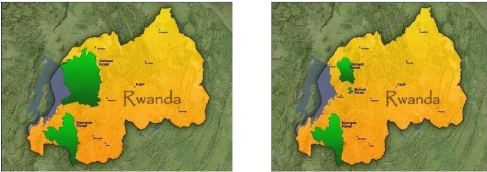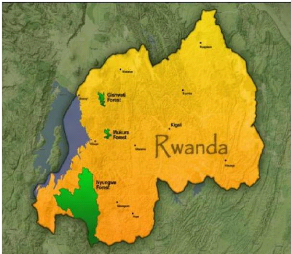3.1.3. GENERALITY ON THE FOREST OF RWANDA
The forests of Rwanda have experienced the alarming deforestation
in the last decades which has led to the extinction of the almost their total
surface area.
Table 2.Evolution of forests and natural reserves
between 1958 and 2000 (in ha)
|
Formation
|
1958
|
1970
|
1980
|
1990
|
1996
|
2000
|
now in
%
|
|
Natural forests
|
634 000
|
591 800
|
513 600
|
415 200
|
383 700
|
221 200
|
35
|
|
Nyungwe +
Cyamudongo
|
114 000
|
108 800
|
97 500
|
97 500
|
94 500
|
92 400
|
81
|
|
Gishwati
|
28 000
|
28 000
|
23 000
|
8 800
|
3 800
|
6 00
|
2
|
|
Mukura
|
3 000
|
3 000
|
2 100
|
2 100
|
1 600
|
1 200
|
40
|
|
VNP
|
34 000
|
16 000
|
15 000
|
12 800
|
12 800
|
12 000
|
35
|
|
Akagera NP
|
241 000
|
241 000
|
241 000
|
241 000
|
241 000
|
90 000
|
37
|
|
Hunting domain of Umutara
|
64 000
|
45 000
|
45 000
|
34 000
|
0
|
0
|
0
|
|
Savanna
of the
East +
galleries
|
150 000
|
150 000
|
90 000
|
55 000
|
30 000
|
25 000
|
17
|
|
Planted forest
|
24 500
|
27 200
|
80 000
|
247 000
|
232 500
|
252 000
|
1028 000
|
|
Total
|
658 500
|
619 000
|
593 600
|
696700
|
616700
|
473 200
|
72
|
Source: NISR, 2005
21

Gishwati forest 1900 Gishwati forest 1980

Gishwati forest 2008
Source: Rutabingwa, 2010
Figure 5.Reduction of Gishwati
forest
22
3.2. PRESENTATION OF RESEARCH FINDINGS AND DISCUSSIONS
When analyzing the impacts of land use change it is important
to understand the different land uses being undertaken in the study region, and
the variety of ways in which they have been changing in recent years. Land use
change is not a simple matter of a shift in the area of land used for a
particular commodity; it may involve a range of changes including change in
what is produced on the land, how it is produced, and the intensity of
production, amongst others.
Understanding land use change requires carefully defining what
is considered to be a land use', so that changes in these land uses
can be examined. Defining a land use can be challenging -- what activities
should be considered to form part of a single land use' when every
land use can be undertaken in many ways? While some sectors and interest groups
may adopt formal definitions of particular land uses, in this study land uses
were defined based on the ways participants defined them in everyday
language.
A wide range of land uses in the interviews, and often used
multiple terms to refer to a particular land use. It was not always clear where
the boundaries of one type of land use ended and another land use began.
Interviewers were therefore asked to discuss the similarities and differences
between different land uses; to assist in defining what should be considered a
single land use, and where an activity may need to be split into more than one
type of land use.
The following key categories of land use are discussed in turn
below. For each, the various ways the land use was defined, and the way it has
been defined for this research based on the discussion held in the interviews,
is described:
? Plantation forestry
? ?Rural residential
? ?Cropping
? ?Grazing enterprises
? Pasture land, pine and cupressus plantations
23
| 

